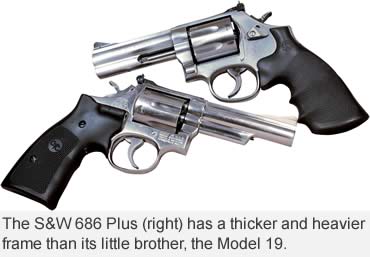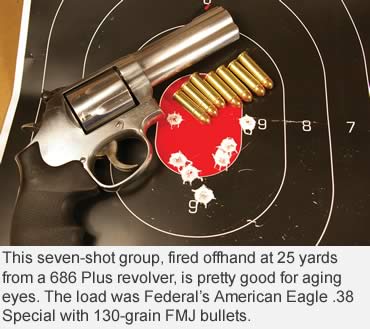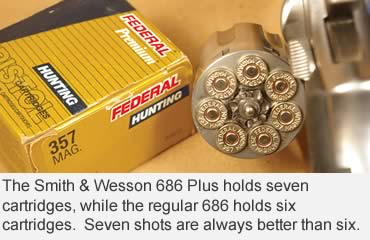This brother of the Model 19 is great for hunting and plinking.
Last summer, I bought a Smith & Wesson Model 686 .357 Magnum revolver, and ever since, I’ve been happily shooting it at the range and in the field.
The gun shoots tight groups from the bench and balances well in the hands for accurate offhand fire. It digests a variety of loads from can-ventilating .38 Specials to stout magnums for hunting.
If all of this praise for the 686 sounds effusive, it’s because I’ve been shooting its older brother, the Model 19 for 35 years.
Smith & Wesson’s .357 Magnum revolvers evolved from a high-pressure version of the .38 Special introduced in 1930. To handle the round, dubbed the .38/44 S&W Special, S&W used the large frame for its .44 Special and called the guns the .38/44 Outdoorsman and .38/44 Heavy Duty revolvers.
Experimenters pushed the cartridge to even higher pressures. Gun writer Phil Sharpe demonstrated the potency of these loads during a hunting trip with Douglas Wesson, then vice president of Smith & Wesson. He was impressed and in 1935, the .357 Magnum was born.
Cases made by Winchester were .135 inches longer than the .38 Special’s. This was not to increase powder capacity, but to prevent cartridges from chambering in older and weaker .38 Special revolvers.
The pressure limit for the .357 was 35,000 pounds per square inch, compared to 17,000 psi for the .38 Special.
The first .357 revolver was built on the large N-frame and called the Registered Magnum. It eventually evolved into the Model 27 and was renowned for its strength and durability.
It was also criticized for excessive size and weight, especially after the .44 Magnum was introduced on the same frame.
 Handgunners called for a slightly smaller-framed .357. Retired U.S. Border Patrol agent and gun writer Bill Jordan favored the K frame with a heavy barrel and a shrouded ejector rod. Smith & Wesson listened, and in 1957 brought out the .357 Combat Magnum, later dubbed the Model 19.
Handgunners called for a slightly smaller-framed .357. Retired U.S. Border Patrol agent and gun writer Bill Jordan favored the K frame with a heavy barrel and a shrouded ejector rod. Smith & Wesson listened, and in 1957 brought out the .357 Combat Magnum, later dubbed the Model 19.
A stainless steel version was the Model 66. The Model 19 and 66 were a bit on the frail side to hold up to steady .357 Magnum fire. That shouldn’t have mattered because knowledgeable lawmen and shooters practiced with .38 Specials but carried revolvers loaded with .357 mags while on duty.
Over the 35 years I’ve owned a nickel-plated Model 19, I’ve fired in the neighborhood of 20,000 .38 Specials and perhaps 100 .357 Magnums, and the revolver is still going strong.
Other shooters complained that the Model 19 would not hold up to constant fire. The Colt Python, introduced in 1955, made matters worse because it was about the same size as the Model 19 and shot .357s without a hitch.
In 1980, Smith & Wesson answered those gripes with its 586 .357 Magnum revolver in blued or nickel-plated steel and the 686 in stainless steel. The guns were made on Smith & Wesson’s new medium large L frame that maintained the K-frame grip. The L frame is somewhat larger and heavier than the K-frame Model 19.
The regular 686 with a 4-inch barrel and six-chamber cylinder weighs 39.7 ounces. I went with the 4-inch 686 Plus seven-shot because one more round is always a good thing. The Plus actually weighs about an ounce less than the standard 686. In contrast, my six-shot Model 19 weighs 36 ounces.
The 686’s 3 ounces of extra weight went into its beefier cylinder, frame and yoke. The cylinder is slightly larger with the locking notches cut between the chambers, while the Model 19’s notches are cut over the chambers.
The front of the 686’s frame is also a bit taller to accommodate the larger cylinder. The forcing cone is thicker, and the frame around the forcing cone is wider and longer than the Model 19’s.
The 686 also has a full-length ejector shroud under the barrel. The single-action trigger on both guns has no creep or overtravel.
The 686’s trigger breaks with 4 pounds of pressure. My Model 19’s trigger is smoother and lighter after years of shooting. It trips with just 3 pounds of pressure. I like the smooth click clack sound of the cocking hammer.
The 686’s firing pin is set in the frame, while the Model 19’s is mounted on the hammer.
 With the 686 in full production, it was only a matter of when Smith & Wesson would drop the Model 19. It was discontinued in 1999, and the Model 66 was dropped in 2005. The blued steel 586 was also terminated.
With the 686 in full production, it was only a matter of when Smith & Wesson would drop the Model 19. It was discontinued in 1999, and the Model 66 was dropped in 2005. The blued steel 586 was also terminated.
When I went shopping for a 686, I was amazed at the assortment of models. I could pick from a six- or seven-shot cylinder, barrel lengths of 2.5, 4 or 6 inches and a fluted or unfluted cylinder.
The 386 XL Hunter with a 6-inch barrel has a scandium-alloy frame that pares gun weight to 30 ounces.
A Pro Series 686 SSR (Stock Service Revolver) bridges the gap between a stock revolver and S&W’s Performance Center revolvers with a custom barrel and an angled ejector shroud.
My 686 Plus revolver with a seven-shot cylinder and 4-inch barrel has worked out great. The Hogue Monogrip’s finger grooves and tacky rubber provide a nonslip grip. The 4-inch barrel makes the gun compact and easy to carry in a hip holster while hiking in the mountains.
That barrel also provides a 6-inch sighting plane for precise alignment of the red ramp front sight in the rear sight with a white outline.
A 4-inch .357 barrel provides quite an increase in bullet speed compared to a 2.5-inch barrel, but gives up little velocity to a 6-inch barrel.
The muzzle velocity of Federal American Eagle .38 Special cartridges with 130-Grain FMJ bullets was 765 fps from a 2.5-inch barrel, 829 fps from a 4-inch-barrel, and 870 fps from a 6-inch barrel.
Handloaded .357 Magnums with Nosler 158-grain HP bullets and 17.0 grains of Lil’Gun clocked 1,018 fps from the a 2.5-inch barrel, 1,185 fps from the 4 inch and 1,253 fps from the 6-inch model.
For all the .38 Special and .357 Magnum loads I shot in those guns, the 4-inch barrel gained 121 fps over the 2.5-inch barrel, but lost only 59 fps to the 6-inch barrel.
Clamped in a Caldwell Hammer rest, the 686 shot two five-shot, 25-yard groups averaging 1.40 inches with bullets cast from an RCBS 38-150-SWC.
Groups of Hornady’s 110-grain HPs averaged 1.53 inches, and Sierra 125-grain JHC bullets measured 1.84 inches.
With loaded .357 magnums, the revolver fired groups averaging 1.51 inches with Sierra 140-grain JHCs, and .81 inch with Hornady 158-grain FP XTP bullets.
Cast bullets in magnum cases also shot well in the revolver, with the Lyman 358156 lead-alloy cast bullet grouping 1.04 inches.
 The true worth of a revolver is how well it shoots offhand and from an improvised rest in the field. The 686’s full-length ejector shroud places the balance toward the muzzle, so only a bit of wrist tension is required to steady the sights.
The true worth of a revolver is how well it shoots offhand and from an improvised rest in the field. The 686’s full-length ejector shroud places the balance toward the muzzle, so only a bit of wrist tension is required to steady the sights.
Firing the 686 offhand, I can keep seven Federal American Eagle .38 Special cartridges with 130-grain FMJ bullets in about 3 inches at 25 yards. With the revolver fully extended while sitting with my forearms pinched between my knees, I can keep five magnum loads with Lyman cast bullets in about 5 inches at 50 yards.
My son showed me the 686 is capable of even better accuracy. Using the same load, he put five of the Lyman bullets in 1.5 inches at 50 yards. Ah, young eyes.
So far, my son and I have shot about 1,500 rounds through the gun. More than half of those have been magnum loads, too.
I kind of forgot how I enjoyed the sharp report and just enough twist of the wrist from those stout magnum loads. But with the 686 Plus, I’m ready for more of that delight and another 35 years of shooting .357 magnum revolvers.
Read Recent GunHunter Articles:
• Remington’s Classic Rimfire: After 54 years of service, the Model 552 Speedmaster is still one of the sleekest .22 autoloaders available.
• Savage Model 25 Lightweight Varmint Rifle: A varminter needn’t be cumbersome to be accurate.
This article was first printed in the July 2011 edition of Buckmasters GunHunter Magazine. Subscribe today to have GunHunter delivered to your home.